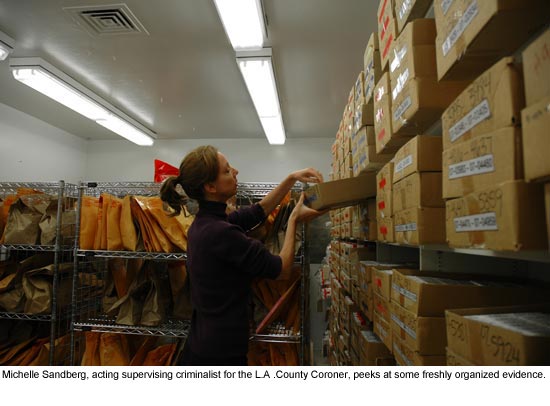Coroner cleans up at awards time
November 3, 2011
Los Angeles County appreciates efficiency, and the coroner has the evidence to prove it.
After DNA revolutionized forensic science, criminal cases that had been “cold” for years suddenly got warmer. Law enforcement agencies formed special units to take fresh looks at them, and coroner’s Evidence Control Unit, which keeps material from more than 60,000 homicides, found itself flooded with requests.
Before 2008, that evidence was stored warehouse-style, each piece catalogued numerically. Evidence from one homicide could be spread across several rooms within piles of other evidence, which made gathering it a time-consuming chore. Before the widespread use of DNA testing, the evidence unit received very few requests from police, so easy access wasn’t a priority. In most cases, law enforcement agencies didn’t even know the evidence was there.
Enter Michelle Sandberg. In 2008, Sandberg, who was working as a toxicologist, was chosen to bring the unit into the new era, to meet the new demand. Due to budget constraints she could not hire extra hands, so she enlisted volunteers from universities and the military to help her and two other staffers come up with a new way of doing business.
Their efforts paid off. On October 19, the evidence control unit makeover will be honored as one of the ten most innovative programs in the county at the 25th Annual Productivity and Quality Awards luncheon. The top three programs among them will win Bronze, Silver and Gold Eagle awards. Winners can then submit applications for awards from the California State Association of Counties and the National Association of Counties.
This year’s other honorees range from a groundwater reclamation program that saves an estimated $236 million annually to a free-for-taxpayers high school STD prevention program that has health and educational benefits that aren’t easily monetized.
The awards are presented by the county’s Quality and Productivity Commission. Over the past 25 years, the programs it has recognized have saved taxpayers an estimated $3.6 billion. Winners are also highlighted in an annual multimedia report, which promotes “best practices” countywide. (See last year’s report here.)
Ruth Wong, executive director of the commission, said the goal is to inspire copycats. “What we are hoping is that all or part of these projects will be picked up by other departments. We want them to spread.”
Already, news of the evidence unit’s success is spreading. The National Institute of Justice sent a representative to have a look at Sandberg’s shop two weeks ago. Sandberg, now acting supervising criminalist, and the director of the coroner’s office, Anthony T. Hernandez, have been invited to Washington, D.C. this March to address the Working Group for Medicolegal Death Investigation, which establishes nationwide standards for evidence management.
She will explain how her team tackled the problem, organizing the evidence in “kits” for each case. Each was labeled with a case number and a list of contents, and added to a computer database shared by 145 agencies nationwide. The Los Angeles Police Department and the L.A. County Sheriff now work closely with the unit, lending staff and advice.
Sandberg’s system has become so efficient that she has started contacting law enforcement agencies herself so they can “come get their stuff.” Out of the 280,000 pieces of evidence her unit housed, only 30,000 remain. As a result of that effort, 41,000 cases have been processed in two years, and decades-old murders and rapes have been solved.
Recognition for her unit’s transformation is great, Sandberg said, but even more gratifying is the sense of contributing to those successful investigations. “It is rewarding because of the work the detectives have done on the cases, using the evidence,” she said. “There is justice for the victims’ families and for all the people who have worked so hard to get it.”
Posted 10/6/11













 405 bridge work causes a stink
405 bridge work causes a stink
